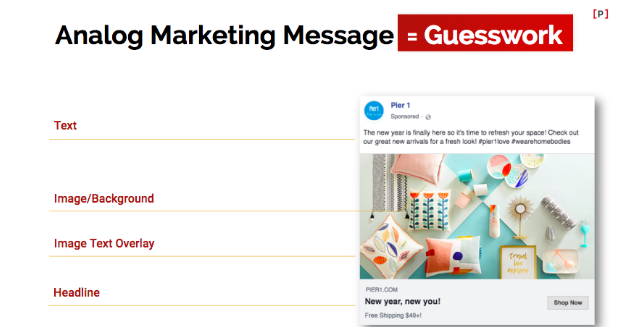Marketers play a foundational role in bringing customers to the business. Yet we have long struggled to communicate our impact to data-driven stakeholders in the C-suite, including the CFO and the CEO. Digital channels are helping to change that by providing data about engagement with our content. Click through rates, impressions, and other metrics help us see where we are capturing customer attention. But in the end, the metric that the business cares about optimizing the conversion rate.
A “conversion” means different things depending on the context or the business. In general, a “conversion” comes about when a customer or prospect takes the action that a campaign is designed to motivate. The more you optimize your conversion rate, the more business your marketing efforts are likely to generate. Conversion rate optimization is therefore a key strategy for ambitious marketers. This blog offers some tips on how to achieve it. But first, let’s dig into what we mean by conversion rate optimization, how to define it, and how to measure it.
What is conversion rate optimization (CRO)?
As the term implies, conversion rate optimization is the process of motivating the largest possible percentage of audience members to the action your campaign is designed to elicit. For a lender aiming to provide personal credit, conversion rate optimization may focus on motivating the largest possible share of prospective borrowers to fill out a loan application. A retail brand may want to optimize the share of visitors that sign up for the loyalty program. A healthcare subscriber may want to motivate customers to sign up for automatic prescription refills. And so on.
Adopting a customer-centric definition of CRO
Conversion rate optimization is by definition a data-driven, metric-driven method for designing communications efforts for impact, and then measuring the results. Focus too much on the numbers, however, and you can lose sight of the human factor. Behind those numbers and percentages there are actual people engaged with your brand and making decisions about where to spend their time and money. Ignore that human element, and you may struggle to improve your conversion rate optimization.
A stronger approach is to marry the power of data-informed engagement with deep knowledge of what motivates customers to take action. As important is what shuts them down. Designing the user experience across your channels with an eye on seamlessly delivering what customers want and need at the different points along the journey will organically optimize conversion at every stage.How can brands do that? By gathering insights into the core experience of the customer with your brand. Ask questions like:
- How do your audiences engage with you?
- What are your most successful channels?
- What beliefs about you exist in the market?
- What words and feelings does your brand evoke?
- At which key moments do you need to improve the customer experience?
These insights — or the equivalent for your organization — can help inform where you need to optimize conversions and the approaches you need to do it.
Focusing on the customer provides a North Star for what to improve. Another key element in conversion rate optimization is to calculate your current conversion rate baseline so you can set targets for success.
How to calculate conversion rates
Brands calculate conversion rates by taking the number of people who took a desired action (i.e. the number of conversions) by the number of people who saw the message or campaign geared to motivate it.
Take, for example, a common retail strategy of using banners to promote a discount code. If 10,000 people visited the site when the banner was up, and 250 people used the code to check out, the conversion rate was 2.5%.
What’s the average conversion rate?
Every industry has benchmarks representing the average conversion rates for certain actions. Different industries may even have more nuanced data about the conversion rates for different stages of the customer journey.
The average e-commerce site conversion rate in the US in the third quarter of 2020, for example, was 2.57%, according to Statista. For organizations in the e-commerce business, conversion rate optimization efforts may aim to exceed that industry average, or may use a more nuanced metric for their sub-sector or based on the historical performance of their business.
6-step conversion rate optimization framework
Once you understand what conversion rate optimization is, why you should pursue it, and how to measure it, it’s time to drill into how to do it.
The answer is, through a six-step framework that closely mirrors design thinking, the scientific method, problem solving methodologies, and other cyclical processes designed to enable learning and improvement. Progressing through the successive stages of research, hypothesis setting, prioritizing, designing, testing, learning, and back to research allows you to understand the customer experience of today and what needs to change within it to motivate the actions you want to see.
Step 1: Research
The goal of research is to understand how your customers and prospects use your channels today, and where the experience you deliver is falling short when it comes to conversions. There is an array of research methods and approaches available to you. They include quantitative tools like website analytics and net promoter scores, and qualitative tools like consumer experience surveys and sentiment analysis. you don’t have to use all of them in every case. It helps to first ask a concrete question and then identify the research methods that are most likely to give you a helpful answer.
One of the first questions you need to answer for conversion rate optimization is, what is your conversion rate now? That baseline is the metric against which you will determine the success of your efforts.
Beyond the baseline question, businesses hoping to drive conversion rate optimization may ask basic questions about the user behavior on their website. Such as, how many visitors do we get? How long do they stay? What path do they follow, along which pages? Of those visitors who bounce, when does it happen and on what page(s)? Answers to those questions can be teased out, at least in part, using web site analytics.
But even the most robust website analytics tools cannot give you the full picture of what customers are doing on your site. Marketers like to believe our visitors are giving our lovingly developed web pages their full attention, and therefore that website analytics provide a clear representation of what motivates people to act in certain ways. In reality, however, visitors may not be paying attention at all. A longer-than-average visit could be a reflection of higher interest in what you have to offer, or it could be a visitor who got distracted simultaneously texting a friend or ordering dinner.
For a better understanding of the nuances and motivations related to user behavior on your channels, drill down to gather another layer of nuanced insights. You can use experience surveys, focus groups, or user observations – all different forms of primary research – to gather that more nuanced view.
Step 2: Hypothesize
Once you have done enough research, it is time to develop a hypothesis about the elements that could improve your conversion rate. The strongest hypotheses are testable, and thus are quantitative and time-bound. Some examples are:
A shorter, more action-oriented hero text will increase click through rates by 5% within two months. A picture of a dog will increase sales of our bedding products by 7% during the holiday shopping season.
A thorough research and discovery process will uncover a host of hypotheses, each of them is likely to have multiple design options associated with it. For example, that dog hypothesis is cute — but what kind of dog? What color? An adult dog or a puppy? Is it on the bed ? Is it sleeping or playing? Are there people with it? Adults or kids?
With today’s modern testing capabilities – including A/B as well as multivariate tests — marketers can create multiple variants related to the main concept and test which ones garner the best response. There are still limits, however, which brings us to the next step: prioritization.
Step 3: Prioritize
It could very quickly get unmanageable to test every potential hypothesis you have — let alone the many variants you could generate for each. To avoid overwhelming yourself, you need to prioritize.
Start at the level of the hypothesis to map them based on theoretical impact in relation to the level of effort. If it’s helpful, you can use a four-square framework, with the X-axis representing potential impact and the Y-axis representing likely effort. Many organizations may choose to prioritize working on the hypotheses that seem likely to generate the biggest results for the least amount of effort. To get more nuanced, you can add a confidence interval – that is, you weigh different options based on how confident you are that your benefit estimates are correct. This can make it easier to choose between two hypotheses that seem equally impactful with the same amount of effort.
Step 4: Design
Once you’ve decided which hypotheses to pursue, it is time to design the experiment. A number of factors come into play here, such as the number of variants you want to test, the number of different variables (e.g. the age of the dog, where it’s placed, etc.), the sample size you need to reach statistical significance, and so on. It is helpful to return to that hypothesis as you are designing the experiment to ensure that your design is set up to validate or negate your hypothesis — and not some other, unrelated point.
Step 5: Test
Run your test — and try your best to stick to the parameters you defined when establishing the test design. Don’t stop the test early, or reduce your desired sample size, or change your hypothesis in mid-flight
Step 6: Learn
Once you have your experiment results, it is time to analyze them. Was your hypothesis proven or disproven — in other words, did your change perform better, worse, or the same as your baseline. If it performed worse, take a moment to examine your experimental results for insights on why. What assumptions did you make based on your research that turned out to be wrong? Those learnings can inform the next hypothesis you choose to prioritize.
It is equally important to reflect on the “why” when your hypothesis is proven correct, as there may be a nuance or aspect to why the change outperformed the baseline that can inform what you do next to drive conversion rate optimization.
The foundation of modern CRO: Personalization
This iterative, 6-part conversion rate optimization process can be modified for any business at any level of complexity — including those that are embracing personalization.
Personalization has become a customer expectation. More than 70% of customers expect personalized experiences and get frustrated when they don’t get them, according to McKinsey. Customers are more likely to buy from a company and recommend one that has delivered a relevant and personalized experience. On the flip side, organizations that fail to deliver personalized experiences risk losing close to 40 percent of their customers, according to studies by Twilio and Gartner.
In the world of conversion rate optimization, this means that the 6-part conversion rate optimization framework should be executed with an eye on highlighting differentiated experiences based on the preferences of distinct, high-priority customers. Your organization may identify those customers as part of a segment based on specific behaviors they exhibit. Other firms may get even more granular about individual customer behavior. The bottom line is that there won’t be one approach that works for all customers to optimize their conversion rate. You will have to personalize the experience in order to motivate the actions you want them to take.
| Report: Personalization Needs Motivation: The 2022 Persado Customer Motivation Report |
CRO tips for any business
As you identify priority areas for your business to optimize conversion rates, and experiment to pinpoint the exact details that motivate customers to act, keep in mind a number of best practices that will improve the customer experience for any business.
Provide personalized experiences
Know that your customers are dealing with all kinds of unique circumstances that influence their buying behavior. Don’t make the mistake of thinking that two individuals who look similar demographically will have the same motivations when it comes to the brands they frequent.
Instead, take the time to understand their buying behavior and what they prioritize. Focus your conversion rate optimization efforts on delivering a custom experience that taps into their unique motivations.
For example, a credit card company with a new loyalty card promoted it using different images and ad copy to different customer groups. Customers that had shown a tendency to redeem rewards for travel received a travel-related message, whereas those who’d redeemed rewards for cash received a different ad. Using different messages improved performance for both. That’s just one simple example of how brands can deliver personalized experiences to make the customer feel like you know them and care about their preferences.
| Ebook: AI Has Launched a $800 Billion Revolution in Content Personalization Worldwide |
Use emotive language
The right words make all the difference between a message that motivates action and one that falls flat. Often it is the emotional context of a word or phrase that captures a given customer’s attention. It goes without saying that different customers may engage with different emotions. For example, banking customers with high savings rates and low levels of debt are more likely to respond to messages from their bank that express Gratitude. In contrast, customers that have low savings rates and high levels of debt react more to messages that aim to grab Attention. To get the biggest response, don’t be afraid to get emotional.
Use social proof to build trust
People are more likely to trust a brand when they see others having a positive experience with it. That concept of “social proof” was documented in detail in the book Influence by Robert Cialdini, and comes in many forms. Some customers feel motivated when they hear product or brand endorsements by people they view as experts; some are influenced by celebrities; some like to see others who are “like them”, in the sense that they’re in similar situations or have similar needs. As with everything, brands will need to personalize the forms of social proof they establish to build trust with their audience.
Create a sense of scarcity
People don’t feel like they need to make a decision when they believe they have unlimited time or unlimited access. To motivate action, brands need to create urgency, either by putting a time-limit on an offer — Sales Ends Friday! — or suggesting a resource limit.
Simplify the checkout flow
Making it easy and seamless to go from looking at a product to buying it is a proven way to increase conversions. It comes down to simple math: by limiting the number of steps involved, you limit the number of opportunities customers have to change their minds and abandon the purchase. Keeping things simple and with a minimum number of steps pushes a larger share of customers through the end of the process.
Optimize the mobile experience
Mobile phones have become an increasingly important channel for e-commerce. Whether customers only use their phones to research and explore products, or whether they use them for the entire end-to-end process, there’s no doubt that mobile experiences are a key part of the customer journey. Optimize your site for mobile devices and provide smooth in-app navigation experiences to facilitate conversion.
Help people solve their own problems
Ideally, you are streamlining and improving your digital channel experiences so that prospects and customers don’t experience service issues. But if they do, make it easy for them to solve the problem without recourse to a chat bot or call center agent. Self-service features on your web site, in-app, and through other channels empower people to answer their own questions quickly, before they get frustrated and give up on engaging with you.
Retarget website visitors
Customers that browse your site, choose a product, and then abandon the process are prime candidates for retargeting. Third-party cookies made this easy to do, but as those tools exit the market, brands have other methods to pursue. For example, send a customer you recognize an email reminding them of their abandoned cart. Depending on the customer, you could add an incentive such as a discount or a coupon. And don’t forget to assess who is abandoning their card and why to determine if there is a hypothesis you can test in a future improvement experiment.
Collect feedback from customers
You should already be doing this as part of your research efforts outlined in the 6-step process. The key take-away is not to stop. Conversion rate optimization is not a one-and-done event but a constant and ongoing process that you constantly engage in. Research is a key part of how you reset your baseline and your improvement targets and identify new hypotheses to…
Test, test, test
That’s right — keep testing. The only way to know whether a change in the experience improves the conversion rate is to reset our baseline and retest the new experience.
Increasing Conversion Rates with Motivation AI
Businesses are becoming more quantitative across functions and business units, and marketing is no exception. This is good news, as it lets marketers speak in the language of the CFO and CEO to highlight where we are having impact on the business. And there is no clearer way to show how we are driving revenue than by highlighting our conversion rate impact. Follow these tips to set yourself up for success.
All of the strategies highlighted will improve your conversion rate. An even higher multiple of impact is possible by marrying these techniques with messages generated by Persado’s Motivation AI platform, which enables personalized communications at scale by generating the specific communications and language that motivates each individual to immediately inspire each individual to engage and act.
If you’re a leader that needs to optimize conversion rates and improve performance across touchpoints and channels, from acquisition to loyalty, and you need to meet your customer’s expectation of personalized experiences, Motivation AI is able to quickly unearth what’s working, identify optimizations, and then generate the language that doesn’t just engage, but converts customers at significantly higher rates.
The world’s biggest brands rely on Persado to generate hyper-personalized communications. Organizations that use Persado benefit from a unified platform with powerful underlying components including an extensive customer motivation knowledgebase, language-trained deep learning and AI models, and a predictive motivation decision engine to drive massive value creation. With the Persado Motivation AI Platform, the top 30 Persado customers alone have recognized over $1.5 billion in incremental revenue.
Tap into the power of Motivation AI for driving conversion rate optimization today. Learn more.



